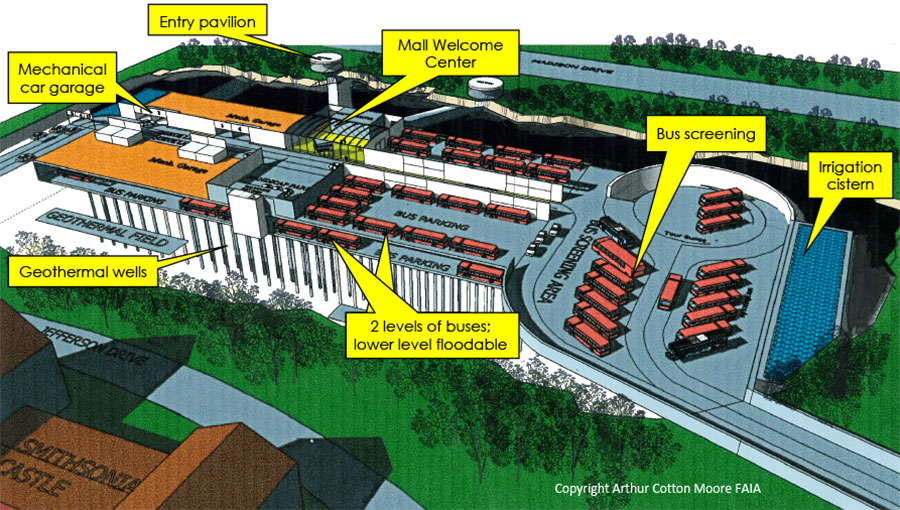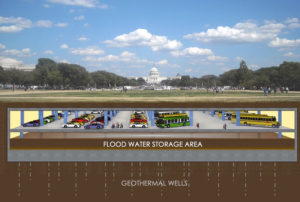 A MULTI-PURPOSE SOLUTION FOR A RESILIENT MALL
A MULTI-PURPOSE SOLUTION FOR A RESILIENT MALL
Since 2013 the National Mall Coalition has developed the National Mall Underground project in consultation with relevant federal and DC agencies, as well as experts in architecture, engineering, construction, law, finance, and community development. The multiple elements of the project are intended to provide the greatest possible benefits to the American public and all Mall stakeholders. Features include:
- A stormwater reservoir capable of collecting 30 million gallons of flood water (more than the predicted volume of a 200-year storm) to protect Mall and Federal Triangle buildings from flooding.
- Two levels of tour bus and car parking to relieve surface congestion on the Mall, improve visitors’ Mall experience, and reduce significant air pollution. (A 2015 study concluded the National Mall Underground “would be the most dramatic improvement in bus parking capacity if constructed.”)
- A welcome center to provide visitors to the Mall with an orientation to its history and future as well as the neighboring museums and monuments; public amenities; and security and first aid facilities.
- Irrigation cisterns to collect rainwater and groundwater for sustainable irrigation.
- A geothermal field and related infrastructure to provide clean heating and cooling to nearby public buildings.
HOW IT WORKS
Watch a Two-Minute Virtual Tour of National Mall Underground
Flooding — During heavy storms, vehicles will be removed from the lower stories to allow flood waters to flow into these areas until they can be pumped out later into the sewer system. Solving the stormwater flooding problem along the Mall and Federal Triangle area could potentially shrink the FEMA flood map flood zone associated with stormwater or interior flooding (shown with blue hatching), and reduce or eliminate the burdens associated with buildings located in that flood area.
stormwater flooding problem along the Mall and Federal Triangle area could potentially shrink the FEMA flood map flood zone associated with stormwater or interior flooding (shown with blue hatching), and reduce or eliminate the burdens associated with buildings located in that flood area.
Irrigation — Cisterns at each end of the facility will collect rainwater and groundwater flow to be used for Mall irrigation and as grey water for visitor center restrooms.
Bus Parking — With tour buses paying millions of dollars a year in parking tickets, the National Mall Underground will provide ample parking to solve this enduring problem and reduce pollution by eliminating bus idling and circling. A rest area for bus drivers will provide showers and places to rest and relax.
Automated Parking — A mechanical two-story car parking system provides convenient and cost effective equal access for Mall visitors. Automated parking produces 83% less toxic fumes than conventional garages.
 Welcome Center — The Underground will feature a Mall Welcome Center with plentiful restrooms, food options, First Aid, and other amenities that are lacking today for visitors on the Mall. An educational exhibit will explain the water resources function of the facility including the recycling of greywater collected in the cisterns for use in the restrooms.
Welcome Center — The Underground will feature a Mall Welcome Center with plentiful restrooms, food options, First Aid, and other amenities that are lacking today for visitors on the Mall. An educational exhibit will explain the water resources function of the facility including the recycling of greywater collected in the cisterns for use in the restrooms.
Geothermal — The field of geothermal wells beneath the facility will be able to provide efficient, cooling energy to the nearby Smithsonian museums as well as other public buildings.
Security — The Underground will not only include a security office and a first aid station, but will also provide shelter to Mall visitors during sudden down-pours. Federal agencies charged with national security and public safety have reviewed the project and found no security concerns. Indeed, the Underground will provide new public safety benefits. According to security experts, it can be used in staging such high-profile events such as the Presidential Inauguration and the Fourth of July.
Review an in-depth presentation of the National Mall Underground

